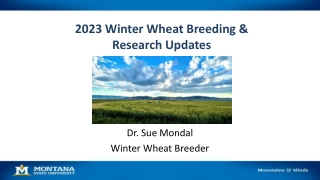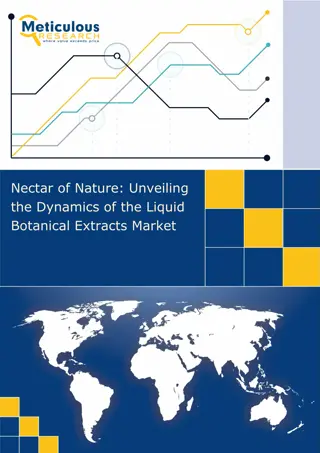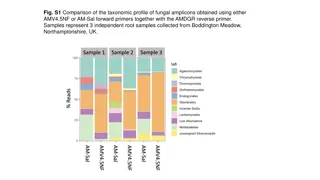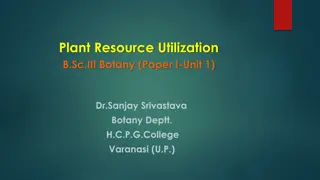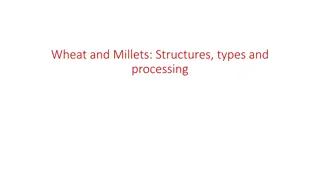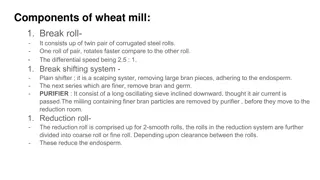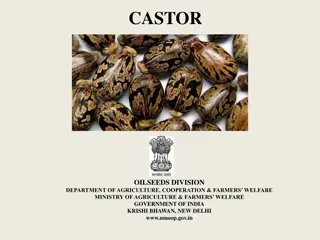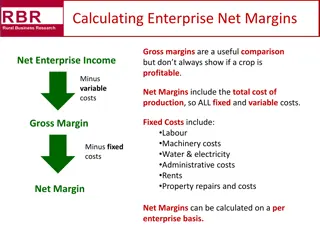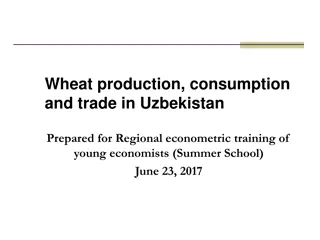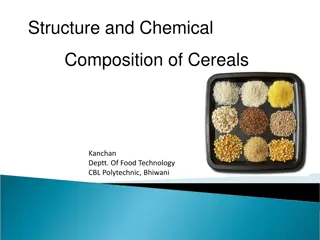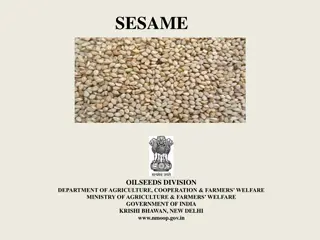Understanding Wheat: Origin, Cultivation, and Botanical Description
Cereals, particularly wheat, hold significant historical importance in human civilization. Originating around 8000 BC, wheat cultivation evolved over time, with different varieties like hexaploid, diploid, and tetraploid emerging. The botanical description of wheat highlights its annual nature, linear leaf blades, erect spikes, and distinctive flower characteristics. This overview sheds light on the rich history and unique features of this vital crop.
Download Presentation

Please find below an Image/Link to download the presentation.
The content on the website is provided AS IS for your information and personal use only. It may not be sold, licensed, or shared on other websites without obtaining consent from the author. Download presentation by click this link. If you encounter any issues during the download, it is possible that the publisher has removed the file from their server.
E N D
Presentation Transcript
Cereal Crop Wheat Unit-2 Prepared by Miss Kavita Basumatary Assistant Professor Department of Botany Goalpara College, Assam
Introduction Plants from the family Gramineae, whose grains are used as food are called Cereals. The name cereal has been given in honor of the roman Goddess- Ceres . Characters- caryopsis fruit, spike inflorescence, alternate leaves with ligules, delicate and rounded stems, annual or perennial herb.
Wheat Its Origin Cultivation of wheat started after 8000 BC. Emmer wheat is said to be 1stcultivated in the Fertile Crescent about 8500 BC. Archaeological analysis of wild emmer indicates that it was first cultivated in the southern Levant with Iran as far back as 9600 BC. Genetic analysis of wild einkorn wheat suggests that it was first grown in the Karacadeg Mountain in South eastern Turkey.
Remains of harvested emmer from several sites near the Karacadag Range have been dated back to Neolithic period. The cultivation of emmer reached Greece, Cyprus and India by 6500 BC, Egypt after 6000 BC and Germany and Spain by 5000 BC. By 3000 BC, wheat had reached England and Scandinavia. A millennium later it reached China. The first identifiable bread wheat (Triticum aestivum) with sufficient gluten for yeasted breads has been identified using DNA analysis in samples from a granary dating to approximately 1350 BC at Assiros in Greek Macedonia.
Wheat varieties varieties Hexaploid Diploid Tetraploid 6n=42 2n=14 4n=28 T. T. T. aestivum T. vulgar T. durum T. dicoccum spherococcum monococcum
Botanical description Annual plant. Leaf blades- linear, flat, auricled. Inflorescence- erect spikes, spikelets solitary, sessile, compressed, 2- several flowered. Flower- glumes ovate, persistent, shortly awned; lemmas oblong, ventricose, awned; palea equalling the lemma, lodicules-2, stamens-3, style very short.
Climate and Temperature Rabi crop. Sowing- November December. Harvesting- March April. Average temperature- 20-25 C Germination stage- 20-25 C Vegetative stage- 20-23 C Reproductive stage- 23-25 C
Cultivation The soil must be properly prepared before starting the wheat farming. For this you can plough the soil either with disc or mould board plough. Then arrange the soil by giving one deep plough, followed by 2 to 3 light ploughing and planking. Now add natural fertilizers to it. For commercial wheat farming, an average of 50 kg Nitrogen, 25 kg Phosphorus and 12 kg Potash is sufficient in one acre of land. Add more organic contents while preparing the soil.
The wheat seeds must be sown in about 4 to 5 cm inside the soil. Always put the seeds in rows and maintain a spacing of 20-22.5 cm between the rows. Planting or sowing the seeds in the right time is also important as delayed sowing can cause a gradual decline in the production. In India, it is generally sown in the end of October and early November. Also see that the wheat seeds is properly graded and thoroughly cleaned before sowing. Here you can apply fungicide for treating the seeds.
Harvesting begins in mid February and continues till april. Harvesting starts when the leaves and stem turn yellow in color and become fairly dry. Harvested grains are threshed by treading. Followed by winnowing.
Commercially available wheat varieties Sonalika Kalyansona Arjun Janak UP 301 & UP 262 Pratap PV 18 WG 357 & 377 Girija Shailaja Sharbati sonora Choti lerma
Green Revolution The Green Revolution was an endeavour initiated by Norman Borlaug in the 1960s. He is known as the 'Father of Green Revolution' in world. It led to him winning the Nobel Peace Prize in 1970 for his work in developing High Yielding Varieties (HYVs) of wheat. In India, the Green Revolution was mainly led by M.S. Swaminathan. The Green Revolution resulted in a great increase in production of food grains (especially wheat and rice) due to the introduction into developing countries of new, high-yielding variety seeds, beginning in the mid- 20thcentury. Its early dramatic successes were in Mexico and the Indian subcontinent. The Green Revolution, spreading over the period from 1967-68 to 1977- 78, changed India s status from a food-deficient country to one of the world's leading agricultural nations.
Objectives of Green Revolution Short Term: The revolution was launched to address India s hunger crisis during the second Five Year Plan. Long Term: The long term objectives included overall agriculture modernization based on rural development, industrial development; infrastructure, raw material etc. Employment: To provide employment to both agricultural and industrial workers. Scientific Studies: Producing stronger plants which could withstand extreme climates and diseases. Globalization of the Agricultural World: By spreading technology to non-industrialized nations and setting up many corporations in major agricultural areas.
Background of Green Revolution in India In 1943, India suffered from the world s worst recorded food crisis; the Bengal Famine, which led to the death of approximately 4 million people in eastern India due to hunger. Even after independence in 1947, until 1967 the government largely concentrated on expanding the farming areas. But the population was growing at a much faster rate than food production. This called for an immediate and drastic action to increase yield. The action came in the form of the Green Revolution. The green revolution in India refers to a period when Indian Agriculture was converted into an industrial system due to the adoption of modern methods and technology such as the use of HYV seeds, tractors, irrigation facilities, pesticides and fertilizers. It was funded by the US and the Indian Government and the Ford and Rockefeller Foundation. The Green Revolution in India is largely the Wheat Revolution as the wheat production increased by more than three times between 1967-68 and 2003-04, while the overall increase in the production of cereals was only two times
Positive Impacts of Green Revolution Tremendous Increase in Crop Produce: It resulted in a grain output of 131 million tonnes in the year 1978-79 and established India as one of the world's biggest agricultural producers. The crop area under high yielding varieties of wheat and rice grew considerably during the Green Revolution. Reduced Import of Food-Grains: India became self-sufficient in food-grains and had sufficient stock in the central pool, even, at times, India was in a position to export food-grains. The per capita net availability of food-grains has also increased. Benefits to the Farmers: The introduction of the Green Revolution helped the farmers in raising their level of income. Farmers ploughed back their surplus income for improving agricultural productivity. The big farmers with more than 10 hectares of land were particularly benefited by this revolution by investing large amounts of money in various inputs like HYV seeds, fertilizers, machines, etc. It also promoted capitalist farming.
Industrial Growth: The Revolution brought about large scale farm mechanization which created demand for different types of machines like tractors, harvesters, threshers, combines, diesel engines, electric motors, pumping sets, etc. Besides, demand for chemical fertilizers, pesticides, insecticides, weedicides, etc. also increased considerably. Several agricultural products were also used as raw materials in various industries known as agro based industries. Rural Employment: There was an appreciable increase in the demand for labour force due to multiple cropping and use of fertilizers. The Green Revolution created plenty of jobs not only for agricultural workers but also industrial workers by creating related facilities such as factories and hydroelectric power stations.
Negative Impacts of Green Revolution Non-Food Grains Left Out : Although all food-grains including wheat, rice, jowar, bajra and maize have gained from the revolution, other crops such as coarse cereals, pulses and oilseeds were left out of the ambit of the revolution. Major commercial crops like cotton, jute, tea and sugarcane were also left almost untouched by the Green Revolution. Limited Coverage of HYVP: High Yielding Variety Programme (HYVP) was restricted to only five crops: Wheat, Rice, Jowar, Bajra and Maize. Therefore, non-food grains were excluded from the ambit of the new strategy. The HYV seeds in the non-food crops were either not developed so far or they were not good enough for farmers to risk their adoption.
Regional Disparities: Green Revolution technology has given birth to growing disparities in economic development at interred and intra regional levels. It has so far affected only 40 percent of the total cropped area and 60 per cent is still untouched by it. The most affected areas are Punjab, Haryana and western Uttar Pradesh in the north and Andhra Pradesh and Tamil Nadu in the south. It has hardly touched the Eastern region, including Assam, Bihar, West Bengal and Orissa and arid and semi-arid areas of Western and Southern India. The Green Revolution affected only those areas which were already better placed from an agricultural point of view. Thus the problem of regional disparities has further aggravated as a result of the Green Revolution.
Excessive Usage of Chemicals: The Green Revolution resulted in a large-scale use of pesticides and synthetic nitrogen fertilisers for improved irrigation projects and crop varieties. However, little or no efforts were made to educate farmers about the high risk associated with the intensive use of pesticides. Pesticides were sprayed on crops usually by untrained farm labourers without following instructions or precautions. This causes more harm than good to crops and also becomes a cause for environment and soil pollution. Water Consumption: The crops introduced during the green revolution were water-intensive crops. Most of these crops being cereals, required almost 50% of dietary water footprint. Canal systems were introduced, and irrigation pumps also sucked out the groundwater to supply the water-intensive crops, such as sugarcane and rice, thus depleting the groundwater levels. Punjab is a major wheat- and rice-cultivating area, and hence it is one of the highest water depleted regions in India.
Health Hazards: The large-scale use of chemical fertilizers and pesticides such as Phosphamidon, Methomyl, Phorate, Triazophos and Monocrotophos resulted in resulted in a number of critical health illnesses including cancer, renal failure, stillborn babies and birth defects.


